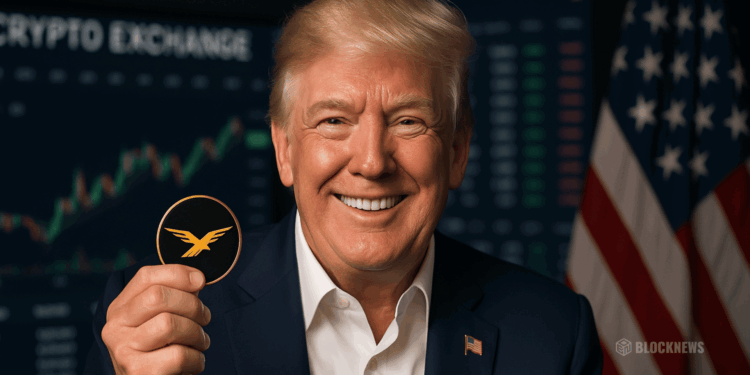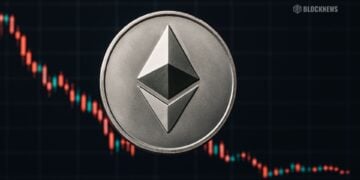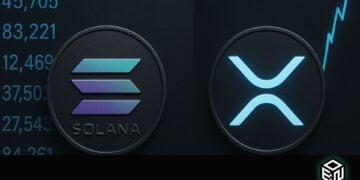- $WLFI launched with a $5B paper gain tied to Trump family allocations.
- Dual-token system ($WLFI + USD1) aims to merge politics with DeFi rails.
- Regulatory heat and unlocks ahead will decide if WLF builds or burns out.
Trump’s crypto footprint just got louder. World Liberty Financial (WLF)—the new umbrella for the $WLFI token—arrives with a full-blown DeFi pitch: governance via WLFI, everyday rails via a dollar-pegged stablecoin called USD1, and a brand that blends politics, finance, and tech into one noisy cocktail. Wild? Kinda. Also… impossible to ignore.
This isn’t another one-off meme coin splash. WLF is positioning itself as a platform—tokens, governance, stablecoin mechanics, a “movement” wrapper—and yes, the Trump family is stitched into the center of it, with co-founder Zach Witkoff front-facing the rollout. Love it or roll your eyes, the project sits right at the edge where narrative meets markets.
What WLF Says It Is (and what it wants to be)
At the core: two tokens, two roles.
- $WLFI → governance, upside, the “voice” of the network.
- USD1 → a dollar-backed stablecoin for payments, settlement, and everyday utility.
The plan is pretty standard DeFi architecture—staking, governance votes, lending/borrowing hooks, cross-border payments—wrapped in a political-freedom narrative. “World Liberty” is no accident. The messaging leans hard on decentralization vs. central bank digital currencies (CBDCs), positioning WLF as a “pro-liberty” financial rail with global ambitions. Big talk. Execution is the real boss here.
The Shock Opener: A $5B Paper Gain (on day one)
Launch day was—no other word—explosive. Based on the family’s allocation × opening price, the Trump camp saw an instantaneous ~$5 billion paper valuation attached to their stake. That number ripped through headlines like a lightning strike. It’s not an IPO with bank-priced ranges and lockstep disclosures; token launches can go vertical on narrative + scarcity, then swing like a barn door when liquidity is thin.
For supporters, the alignment is obvious: a big stake means the family wins only if the ecosystem grows. For critics, it’s a red flag: a multibillion-dollar personal exposure tied to a political figure’s megaphone? That’s not just a story; that’s a storm system. Both can be true. That tension is the point.
Price Action: Whiplash Out the Gate
Within minutes, $WLFI spiked above ~$0.30, then cratered nearly 50%, then rebounded—classic day-one theater. Thin books, bots, retail FOMO, insider locks, headline feedback loops. Except this time it wasn’t a random dog coin on Telegram. It was a token tethered to a former U.S. president. Every tick got airtime. Every wick became a talking point.
Volatility is a feature, not a bug, in early-stage tokens. It creates opportunity and chaos in the same breath. If you traded it, you already know the drill: fast hands win; slow hands learn. But that backdrop—political brand + speculative mechanics—adds a layer most launches never carry.
Vesting, Cliffs, and the Conflict-of-Interest Question
Yes, the family’s allocation is vested. No instant carpet-pull. That’s standard in crypto: it signals commitment, reduces immediate sell pressure, and (in theory) protects the market from day-one dumps. Still, the optics aren’t simple.
- Critic view: Even with vesting, a giant insider stack tied to a political figure invites conflict-of-interest concerns. Policy, public comments, even campaign posture could—fairly or not—be read through a price lens.
- Supporter view: Vesting aligns incentives. You only win long-term if you build long-term. Grow ecosystem usage. Push adoption for USD1. Make governance real, not cosplay.
Both sides are staring at the same chart, just from different angles. The real test comes at unlock events. If/when cliffs roll off, how those flows are managed will matter a lot.
Inside the WLF Stack: Governance + Stablecoin
WLF pitches a dual-engine:
- $WLFI (governance): steer the protocol, set parameters, signal direction.
- USD1 (stablecoin): the day-to-day utility layer—payments, transfers, potential merchant rails, maybe remittances if they get serious about integrations.
The project frames itself as global, with backing/ties beyond U.S. borders and a brand narrative that resonates with a base already skeptical of centralized money experiments. That’s a powerful story if the pipes actually work. But storytelling is cheap. Product is hard. And stablecoins don’t win on slogans—they win on trust, liquidity, and real integrations.
The Broader Web: Trump’s Expanding Crypto Universe
WLF doesn’t exist in a vacuum. It sits alongside other Trump-branded ventures—meme-coin experiments and American Bitcoin ($ABTC) among them—forming what looks like a political-crypto portfolio. WLF is the most “serious” of the set: governance mechanics, a stablecoin, a platform stance. It tries to graduate from meme cycles to institution-sized architecture, while still harnessing the attention machine.
This is why people keep calling him the first true “crypto president.” Whether you think that title is earned or ridiculous, it has stuck. And it’s pushing crypto from a niche policy topic into a front-row campaign issue for 2024–2025 and beyond.
Ethics, Oversight, and the Coming Scrutiny
Let’s be blunt: regulators and watchdogs will look at this with a magnifying glass.
- Stablecoins already live under a policy spotlight. Tie one to a political figure, and the questions multiply.
- Governance + allocations + vesting raise “is this a security?” debates.
- Campaign finance angles lurk at the edges—will anyone test those lines?
Supporters argue WLF is a symbolic stand against centralization and regulatory overreach. Detractors frame it as a personal enrichment pipeline lacquered with populist branding. Whatever your take, the outcome will set precedents. That’s not hyperbole.
So… What Happens Next?
Two paths (with a thousand messy branches between them):
- WLF ships: real rails for USD1, useful governance, genuine integrations, developer traction. The brand converts into throughput, not just headlines.
- WLF stalls: narrative outruns delivery, unlocks become overhangs, and regulatory heat drains momentum. The brand carries attention, but the stack doesn’t convert.
Either way, this is already a case study. A political figure launched a full-stack DeFi play and forced the market—and policy world—to respond. That alone moves the Overton window for crypto.
Final Take
$WLFI’s launch wasn’t quiet; it wasn’t meant to be. A $5B paper jolt, violent day-one volatility, and a dual-token ecosystem tied to a presidential brand is something crypto hasn’t seen before. It’s either the opening chapter of a powerfully aligned network—or the loudest headline farm of the cycle.
If you’re watching this space (and you should), track three signals:
- Utility (does USD1 actually get used?),
- Governance reality (are WLFI holders shaping anything meaningful?),
- Unlock discipline (do insiders treat markets like partners, or prey?).
JRNY TV will keep slicing through the spin. For now, one thing’s clear: WLF didn’t just launch a token; it lit up a debate—about money, power, and who gets to build the rails of the next financial era.














